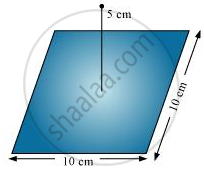Advertisements
Advertisements
Question
An arbitrary surface encloses a dipole. What is the electric flux through this surface?
Solution
According to Gauss' law, the electric flux through an enclosed surface is given by `oint_s vecE * dvecS = q_(enclosed)/ε_0`.
The net charge on a dipole is given by –q + q = 0, hence `q_(enclosed)` = 0
Hence the electric flux through a surface enclosing a dipole = `(-q + q)/ε_0 = q/ε_0` = 0
APPEARS IN
RELATED QUESTIONS
State and explain Gauss’s law.
A point charge +10 μC is a distance 5 cm directly above the centre of a square of side 10 cm, as shown in the Figure. What is the magnitude of the electric flux through the square? (Hint: Think of the square as one face of a cube with edge 10 cm.)

A charge ‘q’ is placed at the centre of a cube of side l. What is the electric flux passing through each face of the cube?
A charge Q is placed at the centre of a cube. Find the flux of the electric field through the six surfaces of the cube.
State Gauss's law in electrostatics. Show, with the help of a suitable example along with the figure, that the outward flux due to a point charge 'q'. in vacuum within a closed surface, is independent of its size or shape and is given by `q/ε_0`
Which of the following statements is not true about Gauss’s law?
Gauss' law helps in ______
Five charges q1, q2, q3, q4, and q5 are fixed at their positions as shown in figure. S is a Gaussian surface. The Gauss’s law is given by `oint_s E.ds = q/ε_0`
Which of the following statements is correct?
If the total charge enclosed by a surface is zero, does it imply that the elecric field everywhere on the surface is zero? Conversely, if the electric field everywhere on a surface is zero, does it imply that net charge inside is zero.
In 1959 Lyttleton and Bondi suggested that the expansion of the Universe could be explained if matter carried a net charge. Suppose that the Universe is made up of hydrogen atoms with a number density N, which is maintained a constant. Let the charge on the proton be: ep = – (1 + y)e where e is the electronic charge.
- Find the critical value of y such that expansion may start.
- Show that the velocity of expansion is proportional to the distance from the centre.
